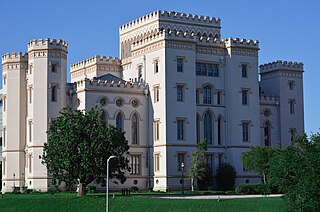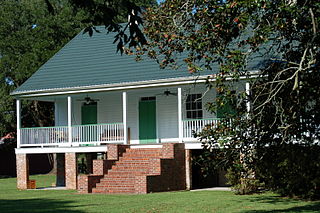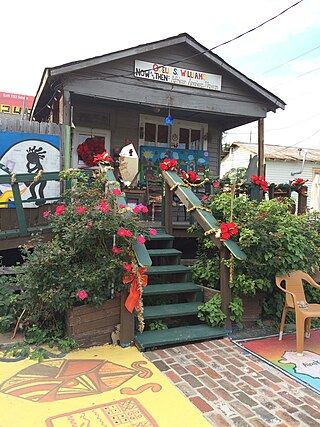
Baton Rouge is the capital city of the U.S. state of Louisiana. Located on the eastern bank of the Mississippi River, it had a population of 227,470 as of 2020; it is the seat of Louisiana's most populous parish (county-equivalent), East Baton Rouge Parish, and the center of Louisiana's second-largest metropolitan area and city, Greater Baton Rouge.

West Baton Rouge Parish is one of the sixty-four parishes in the U.S. state of Louisiana. Established in 1807, its parish seat is Port Allen. With a 2020 census population of 27,199 residents, West Baton Rouge Parish is part of the Baton Rouge metropolitan statistical area.

Port Allen is a city in, and the parish seat of, West Baton Rouge Parish, Louisiana, United States. Located on the west bank of the Mississippi River, it is bordered by Interstate 10 and US Highway 190. The population was 4,939 in 2020. It is part of the Baton Rouge metropolitan statistical area.

The Louisiana State Capitol is the seat of government for the U.S. state of Louisiana and is located in downtown Baton Rouge. The capitol houses the chambers for the Louisiana State Legislature, made up of the House of Representatives and the Senate, as well as the office of the Governor of Louisiana. At 450 feet (137 m) tall and with 34 stories, it is the tallest skyscraper in Baton Rouge, the seventh tallest building in Louisiana, and tallest capitol in the United States. It is located on a 27-acre (110,000 m2) tract, which includes the capitol gardens. The Louisiana State Capitol is often thought of as "Huey Long's monument" due to the influence of the former Governor and U.S. Senator in getting the capitol built. The building's construction was completed in 1931. It was listed on the National Register of Historic Places in 1978 and was designated a National Historic Landmark in 1982.

Raising Cane's River Center is an entertainment complex in downtown Baton Rouge, Louisiana. Opened in 1977, the complex includes: an arena, ballroom, exhibition center, theatre and library. The venue hosts over 500 events per year. In 2016, Raising Cane's Chicken Fingers signed a 10-year naming rights agreement for the River Center.

Baton Rouge Community College is a public community college in Baton Rouge, Louisiana. Established on June 28, 1995, the college settled into a permanent location in 1998. The 60-acre (240,000 m2) campus consists of six main buildings: Governors Building, Louisiana Building, Cypress Building, Bienvenue Student Center, the Magnolia Library and Performing Arts Pavilion, and the Bonne Santé Wellness Center. The college's current enrollment is more than 7,000 students.

The Louisiana State Museum (LSM), founded in New Orleans in 1906, is a statewide system of National Historic Landmarks and modern structures across Louisiana, housing thousands of artifacts and works of art reflecting Louisiana's legacy of historic events and cultural diversity.

The Old Louisiana State Capitol, also known as the State House, is a historic government building, and now a museum, at 100 North Boulevard in Baton Rouge, Louisiana, U.S. It housed the Louisiana State Legislature from the mid-19th century until the current capitol tower building was constructed from 1929-32.

Baton Rouge station is a historic train station located at 100 South River Road in downtown Baton Rouge, Louisiana. It was built for the Yazoo and Mississippi Valley Railroad which got absorbed by the Illinois Central Railroad. The station was a stop on the Y&MV main line between Memphis, Tennessee and New Orleans, Louisiana. The building now houses the Louisiana Art and Science Museum.

Tiger Park is a softball stadium located on the campus of Louisiana State University in Baton Rouge, Louisiana. It serves as the home field of the LSU Lady Tigers softball team and is located south of Skip Bertman Drive across from the LSU School of Veterinary Medicine. The official capacity of the stadium is 2,671 people. Tiger Park's record attendance of 3,242 came on March 25, 2016, in a game versus the University of Florida. The stadium also features an outfield berm, renamed the Tiger Park Terrace in 2016, that can accommodate in excess of 1,200 fans. The stadium opened prior to the 2009 college softball season.

The Pentagon Barracks, also known as the Old United States Barracks, is a complex of buildings located at the corner of State Capitol Drive and River Road in Baton Rouge, Louisiana, in the grounds of the state capitol. The site was used by the Spanish, French, British, Confederate States Army, and United States Army and was part of the short-lived Republic of West Florida. During its use as a military post the site has been visited by such notable figures as Zachary Taylor, Lafayette, Robert E. Lee, George Custer, Jefferson Davis, and Abraham Lincoln.

The Bayou St. John Confederate Submarine is an early military submarine built for use by the Confederate States of America during the American Civil War.
The Louisiana State Archives, established 1956, is the agency under the Secretary of State of Louisiana "designated to fulfill the function of directing a program of collecting, preserving, and making available for use the state's historical records" Located in Baton Rouge, Louisiana, the archives house records from the Spanish, French, and early American past of the state, including vital records, immigration, military, and legislative documents ranging back into the 18th century. The five-panel facade on the building, sculpted by Baton Rouge artist Al Lavergne, offers a panoramic "study in stone" of Louisiana's unique history both as a colony and as a state.

The State Library of Louisiana is Louisiana's state library agency, located in Baton Rouge.

Edward Fairfax Neild Sr., was an American architect originally from Shreveport, Louisiana. He designed the Harry S. Truman Presidential Library and Museum in Independence, Missouri. He was selected for the task by U.S. President Harry Truman.

The Raising Cane's River Center Arena is a multi-purpose arena in Baton Rouge, Louisiana, in the United States. The arena can be combined with the exhibition hall to create more than 100,000 square feet of contiguous convention or exhibit space. The arena which opened in 1977 presents concerts, sporting events, theater events, trade shows, and family shows, with seating for up to 10,400 for concerts, 8,900 for sporting events and 4,500 for theatre events. Besides sporting events, the arena hosts the annual Louisiana Senior Beta Club Convention.

The Odell S. Williams Now And Then African-American History Museum or the Baton Rouge African-American Museum, is a non-profit museum of African-American history and heritage located in Baton Rouge, Louisiana, United States. The museum is named for Odell S. Williams, an educator in Baton Rouge, Louisiana. Founded by Sadie Roberts-Joseph in 2001, the museum remains the only museum dedicated to African and African American history in the city. The museum celebrates Juneteenth, Black History Month, and American history year round.

Pete Goldsby Field is a baseball stadium in Baton Rouge, Louisiana. The park opened in 1956 and has a seating capacity of 2,000.
Capitol High School is a public high school named after the Louisiana State Capitol in Baton Rouge, Louisiana.

















